Extraction of Spatiotemporal Information of Rainfall-Induced Landslides from Remote Sensing
Abstract
1. Introduction
2. Study Area and Datasets
2.1. Study Area
2.2. Multispectral Remote Sensing Imagery Data
2.3. Soil Moisture Products
3. Methods
3.1. Landslide Detection Based on Multisource Remote Sensing Data
3.2. Determining Landslide Timing Based on Hydrometeorological Thresholds
3.3. Model Validation
4. Results
4.1. Identification of Landslide Events and Spatial Distribution
4.2. Temporal Identification of Rainfall-Induced Landslides
4.3. Accuracy Evaluation
5. Discussion
6. Conclusions
- We proposed an automated algorithm to extract spatial information of landslide events based on multisource remote sensing data. First, this approach optimizes the spatial information extraction method for remote sensing landslide events. Utilizing a bi-temporal NDVI change detection method, it considers both the quantity and area accuracy of landslide event extraction. Then, a regional-scale automated algorithm for extracting spatial information of landslide events was designed on the GEE platform, enabling rapid extraction of landslide event spatial information on a regional scale.
- We identified temporal information of rainfall-induced landslide events based on hydrometeorological thresholds. First, a hydrometeorological threshold model was developed considering the antecedent soil saturation and recent rainfall, making it effective for landslide prediction. Second, using this method to classify and temporally identify landslide events extracted from remote sensing, 87.3% of the temporal information recognition errors are noted within 7 days. The temporal identification accuracy of regional rainfall-induced landslide events was enhanced. This demonstrates that the method can establish spatiotemporal information of landslides for areas without recorded landslide data.
Author Contributions
Funding
Data Availability Statement
Conflicts of Interest
References
- Bingli, H.; Lijun, S.; Chonglei, Z.; Bo, Z.; Qijun, X. Mobility Characteristics of Rainfall-Triggered Shallow Landslides in a Forest Area in Mengdong, China. Landslides 2024, 21, 2101–2117. [Google Scholar] [CrossRef]
- Pradhan, B.; Youssef, A.M. Manifestation of Remote Sensing Data and GIS on Landslide Hazard Analysis Using Spatial-Based Statistical Models. Arab. J. Geosci. 2010, 3, 319–326. [Google Scholar] [CrossRef]
- Bessette-Kirton, E.K.; Coe, J.A.; Schulz, W.H.; Cerovski-Darriau, C.; Einbund, M.M. Mobility Characteristics of Debris Slides and Flows Triggered by Hurricane Maria in Puerto Rico. Landslides 2020, 17, 2795–2809. [Google Scholar] [CrossRef]
- Qin, M.; Cui, P.; Jiang, Y.; Guo, J.; Zhang, G.; Ramzan, M. Occurrence of Shallow Landslides Triggered by Increased Hydraulic Conductivity Due to Tree Roots. Landslides 2022, 19, 2593–2604. [Google Scholar] [CrossRef]
- Joyce, K.E.; Belliss, S.E.; Samsonov, S.V.; McNeill, S.J.; Glassey, P.J. A Review of the Status of Satellite Remote Sensing and Image Processing Techniques for Mapping Natural Hazards and Disasters. Prog. Phys. Geogr. Earth Environ. 2009, 33, 183–207. [Google Scholar] [CrossRef]
- Huang, Q.; Wang, C.; Meng, Y.; Chen, J.; Yue, A. Landslide Monitoring Using Change Detection in Multitemporal Optical Imagery. IEEE Geosci. Remote Sens. Lett. 2020, 17, 312–316. [Google Scholar] [CrossRef]
- Lin, W.-T.; Chou, W.-C.; Lin, C.-Y.; Huang, P.-H.; Tsai, J.-S. Vegetation Recovery Monitoring and Assessment at Landslides Caused by Earthquake in Central Taiwan. For. Ecol. Manag. 2005, 210, 55–66. [Google Scholar] [CrossRef]
- Miura, T.; Nagai, S. Landslide Detection with Himawari-8 Geostationary Satellite Data: A Case Study of a Torrential Rain Event in Kyushu, Japan. Remote Sens. 2020, 12, 1734. [Google Scholar] [CrossRef]
- Sajadi, P.; Sang, Y.-F.; Gholamnia, M.; Bonafoni, S.; Brocca, L.; Pradhan, B.; Singh, A. Performance Evaluation of Long NDVI Timeseries from AVHRR, MODIS and Landsat Sensors over Landslide-Prone Locations in Qinghai-Tibetan Plateau. Remote Sens. 2021, 13, 3172. [Google Scholar] [CrossRef]
- Yang, W.; Wang, M.; Shi, P. Using MODIS NDVI Time Series to Identify Geographic Patterns of Landslides in Vegetated Regions. IEEE Geosci. Remote Sens. Lett. 2013, 10, 707–710. [Google Scholar] [CrossRef]
- Ramos-Bernal, R.; Vázquez-Jiménez, R.; Romero-Calcerrada, R.; Arrogante-Funes, P.; Novillo, C. Evaluation of Unsupervised Change Detection Methods Applied to Landslide Inventory Mapping Using ASTER Imagery. Remote Sens. 2018, 10, 1987. [Google Scholar] [CrossRef]
- Plank, S.; Twele, A.; Martinis, S. Landslide Mapping in Vegetated Areas Using Change Detection Based on Optical and Polarimetric SAR Data. Remote Sens. 2016, 8, 307. [Google Scholar] [CrossRef]
- Wen, T.-H.; Teo, T.-A. LANDSLIDE INVENTORY MAPPING FROM LANDSAT-8 NDVI TIME SERIES USING ADAPTIVE LANDSLIDE INTERVAL DETECTION. ISPRS Ann. Photogramm. Remote Sens. Spat. Inf. Sci. 2022, V-3–2022, 557–562. [Google Scholar] [CrossRef]
- Burrows, K.; Marc, O.; Andermann, C. Retrieval of Monsoon Landslide Timings with Sentinel-1 Reveals the Effects of Earthquakes and Extreme Rainfall. Geophys. Res. Lett. 2023, 50, e2023GL104720. [Google Scholar] [CrossRef]
- Illien, L.; Andermann, C.; Sens-Schönfelder, C.; Cook, K.L.; Baidya, K.P.; Adhikari, L.B.; Hovius, N. Subsurface Moisture Regulates Himalayan Groundwater Storage and Discharge. AGU Adv. 2021, 2, e2021AV000398. [Google Scholar] [CrossRef]
- Jones, J.N.; Boulton, S.J.; Stokes, M.; Bennett, G.L.; Whitworth, M.R.Z. 30-Year Record of Himalaya Mass-Wasting Reveals Landscape Perturbations by Extreme Events. Nat. Commun. 2021, 12, 6701. [Google Scholar] [CrossRef] [PubMed]
- Marc, O.; Sens-Schönfelder, C.; Illien, L.; Meunier, P.; Hobiger, M.; Sawazaki, K.; Rault, C.; Hovius, N. Toward Using Seismic Interferometry to Quantify Landscape Mechanical Variations after Earthquakes. Bull. Seismol. Soc. Am. 2021, 111, 1631–1649. [Google Scholar] [CrossRef]
- Ngandam Mfondoum, A.H.; Wokwenmendam Nguet, P.; Mefire Mfondoum, J.V.; Tchindjang, M.; Hakdaoui, S.; Cooper, R.; Gbetkom, P.G.; Penaye, J.; Bekoa, A.; Moudioh, C. Adapting Sudden Landslide Identification Product (SLIP) and Detecting Real-Time Increased Precipitation (DRIP) Algorithms to Map Rainfall-Triggered Landslides in Western Cameroon Highlands (Central-Africa). Geoenviron. Disasters 2021, 8, 17. [Google Scholar] [CrossRef]
- Maturidi, A.M.A.M.; Kasim, N.; Taib, K.A.; Azahar, W.N.A.W. Rainfall-Induced Landslide Thresholds Development by Considering Different Rainfall Parameters: A Review. J. Ecol. Eng. 2021, 22, 85–97. [Google Scholar] [CrossRef]
- Brunetti, M.T.; Peruccacci, S.; Rossi, M.; Luciani, S.; Valigi, D.; Guzzetti, F. Rainfall Thresholds for the Possible Occurrence of Landslides in Italy. Nat. Hazards Earth Syst. Sci. 2010, 10, 447–458. [Google Scholar] [CrossRef]
- Aleotti, P. A Warning System for Rainfall-Induced Shallow Failures. Eng. Geol. 2004, 73, 247–265. [Google Scholar] [CrossRef]
- Dahal, R.K.; Hasegawa, S. Representative Rainfall Thresholds for Landslides in the Nepal Himalaya. Geomorphology 2008, 100, 429–443. [Google Scholar] [CrossRef]
- Melillo, M.; Brunetti, M.T.; Peruccacci, S.; Gariano, S.L.; Roccati, A.; Guzzetti, F. A Tool for the Automatic Calculation of Rainfall Thresholds for Landslide Occurrence. Environ. Model. Softw. 2018, 105, 230–243. [Google Scholar] [CrossRef]
- Lin, M.L.; Jeng, F.S. Characteristics of Hazards Induced by Extremely Heavy Rainfall in Central Taiwan—Typhoon Herb. Eng. Geol. 2000, 58, 191–207. [Google Scholar] [CrossRef]
- Segoni, S.; Piciullo, L.; Gariano, S.L. A Review of the Recent Literature on Rainfall Thresholds for Landslide Occurrence. Landslides 2018, 15, 1483–1501. [Google Scholar] [CrossRef]
- Rosi, A.; Peternel, T.; Jemec-Auflič, M.; Komac, M.; Segoni, S.; Casagli, N. Rainfall Thresholds for Rainfall-Induced Landslides in Slovenia. Landslides 2016, 13, 1571–1577. [Google Scholar] [CrossRef]
- Piciullo, L.; Calvello, M.; Cepeda, J.M. Territorial Early Warning Systems for Rainfall-Induced Landslides. Earth-Sci. Rev. 2018, 179, 228–247. [Google Scholar] [CrossRef]
- Melillo, M.; Brunetti, M.T.; Peruccacci, S.; Gariano, S.L.; Guzzetti, F. An Algorithm for the Objective Reconstruction of Rainfall Events Responsible for Landslides. Landslides 2015, 12, 311–320. [Google Scholar] [CrossRef]
- Huang, F.; Chen, J.; Liu, W.; Huang, J.; Hong, H.; Chen, W. Regional Rainfall-Induced Landslide Hazard Warning Based on Landslide Susceptibility Mapping and a Critical Rainfall Threshold. Geomorphology 2022, 408, 108236. [Google Scholar] [CrossRef]
- Handwerger, A.L.; Huang, M.-H.; Fielding, E.J.; Booth, A.M.; Bürgmann, R. A Shift from Drought to Extreme Rainfall Drives a Stable Landslide to Catastrophic Failure. Sci. Rep. 2019, 9, 1569. [Google Scholar] [CrossRef]
- Zhuo, L.; Dai, Q.; Han, D.; Chen, N.; Zhao, B.; Berti, M. Evaluation of Remotely Sensed Soil Moisture for Landslide Hazard Assessment. IEEE J. Sel. Top. Appl. Earth Obs. Remote Sens. 2019, 12, 162–173. [Google Scholar] [CrossRef]
- Marino, P.; Peres, D.J.; Cancelliere, A.; Greco, R.; Bogaard, T.A. Soil Moisture Information Can Improve Shallow Landslide Forecasting Using the Hydrometeorological Threshold Approach. Landslides 2020, 17, 2041–2054. [Google Scholar] [CrossRef]
- Fusco, F.; Bordoni, M.; Tufano, R.; Vivaldi, V.; Meisina, C.; Valentino, R.; Bittelli, M.; De Vita, P. Hydrological Regimes in Different Slope Environments and Implications on Rainfall Thresholds Triggering Shallow Landslides. Nat. Hazards 2022, 114, 907–939. [Google Scholar] [CrossRef]
- Palau, R.M.; Berenguer, M.; Hürlimann, M.; Sempere-Torres, D. Implementation of Hydrometeorological Thresholds for Regional Landslide Warning in Catalonia (NE Spain). Landslides 2023, 20, 2039–2054. [Google Scholar] [CrossRef]
- Zhao, B.; Dai, Q.; Han, D.; Dai, H.; Mao, J.; Zhuo, L. Probabilistic Thresholds for Landslides Warning by Integrating Soil Moisture Conditions with Rainfall Thresholds. J. Hydrol. 2019, 574, 276–287. [Google Scholar] [CrossRef]
- Brigandì, G.; Aronica, G.T.; Bonaccorso, B.; Gueli, R.; Basile, G. Flood and Landslide Warning Based on Rainfall Thresholds and Soil Moisture Indexes: The HEWS (Hydrohazards Early Warning System) for Sicily. Adv. Geosci. 2017, 44, 79–88. [Google Scholar] [CrossRef]
- Valenzuela, P.; Domínguez-Cuesta, M.J.; Mora García, M.A.; Jiménez-Sánchez, M. Rainfall Thresholds for the Triggering of Landslides Considering Previous Soil Moisture Conditions (Asturias, NW Spain). Landslides 2018, 15, 273–282. [Google Scholar] [CrossRef]
- Wicki, A.; Lehmann, P.; Hauck, C.; Seneviratne, S.I.; Waldner, P.; Stähli, M. Assessing the Potential of Soil Moisture Measurements for Regional Landslide Early Warning. Landslides 2020, 17, 1881–1896. [Google Scholar] [CrossRef]
- Bezak, N.; Jemec Auflič, M.; Mikoš, M. Reanalysis of Soil Moisture Used for Rainfall Thresholds for Rainfall-Induced Landslides: The Italian Case Study. Water 2021, 13, 1977. [Google Scholar] [CrossRef]
- Stanley, T.; Kirschbaum, D.B. A Heuristic Approach to Global Landslide Susceptibility Mapping. Nat. Hazards 2017, 87, 145–164. [Google Scholar] [CrossRef]
- Martelloni, G.; Segoni, S.; Fanti, R.; Catani, F. Rainfall Thresholds for the Forecasting of Landslide Occurrence at Regional Scale. Landslides 2012, 9, 485–495. [Google Scholar] [CrossRef]
- Berti, M.; Martina, M.L.V.; Franceschini, S.; Pignone, S.; Simoni, A.; Pizziolo, M. Probabilistic Rainfall Thresholds for Landslide Occurrence Using a Bayesian Approach. J. Geophys. Res. Earth Surf. 2012, 117, F04006. [Google Scholar] [CrossRef]
- Rossi, M.; Witt, A.; Guzzetti, F.; Malamud, B.D.; Peruccacci, S. Analysis of Historical Landslide Time Series in the Emilia-Romagna Region, Northern Italy. Earth Surf. Process. Landf. 2010, 35, 1123–1137. [Google Scholar] [CrossRef]
- Peters, S.; Liu, J.; Keppel, G.; Wendleder, A.; Xu, P. Detecting Coseismic Landslides in GEE Using Machine Learning Algorithms on Combined Optical and Radar Imagery. Remote Sens. 2024, 16, 1722. [Google Scholar] [CrossRef]
- Prasetya, H.N.E.; Aditama, T.; Sastrawiguna, G.I.; Rizqi, A.F.; Zamroni, A. Analytical Landslides Prone Area by Using Sentinel-2 Satellite Imagery and Geological Data in Google Earth Engine (a Case Study of Cinomati Street, Bantul Regency, Daerah Istimewa Yogyakarta Province, Indonesia). In IOP Conference Series: Earth and Environmental Science; IOP Publishing: Bristol, UK, 2021; Volume 782, p. 022025. [Google Scholar] [CrossRef]
- Wicki, A.; Jansson, P.-E.; Lehmann, P.; Hauck, C.; Stähli, M. Simulated or Measured Soil Moisture: Which One Is Adding More Value to Regional Landslide Early Warning? Hydrol. Earth Syst. Sci. 2021, 25, 4585–4610. [Google Scholar] [CrossRef]
- Thomas, M.A.; Collins, B.D.; Mirus, B.B. Assessing the Feasibility of Satellite-Based Thresholds for Hydrologically Driven Landsliding. Water Resour. Res. 2019, 55, 9006–9023. [Google Scholar] [CrossRef]
- Zhao, B.; Dai, Q.; Zhuo, L.; Zhu, S.; Shen, Q.; Han, D. Assessing the Potential of Different Satellite Soil Moisture Products in Landslide Hazard Assessment. Remote Sens. Environ. 2021, 264, 112583. [Google Scholar] [CrossRef]
- Mirus, B.B.; Becker, R.E.; Baum, R.L.; Smith, J.B. Integrating Real-Time Subsurface Hydrologic Monitoring with Empirical Rainfall Thresholds to Improve Landslide Early Warning. Landslides 2018, 15, 1909–1919. [Google Scholar] [CrossRef]
- Ridd, M.K.; Liu, J. A Comparison of Four Algorithms for Change Detection in an Urban Environment. Remote Sens. Environ. 1998, 63, 95–100. [Google Scholar] [CrossRef]
- Tsai, T.-L.; Chen, H.-F. Effects of Degree of Saturation on Shallow Landslides Triggered by Rainfall. Environ. Earth Sci. 2010, 59, 1285–1295. [Google Scholar] [CrossRef]
- Draper, C.S.; Walker, J.P.; Steinle, P.J.; de Jeu, R.A.M.; Holmes, T.R.H. An Evaluation of AMSR–E Derived Soil Moisture over Australia. Remote Sens. Environ. 2009, 113, 703–710. [Google Scholar] [CrossRef]
- Prakash, N.; Manconi, A.; Loew, S. Mapping Landslides on EO Data: Performance of Deep Learning Models vs. Traditional Machine Learning Models. Remote Sens. 2020, 12, 346. [Google Scholar] [CrossRef]
- Maragaño-Carmona, G.; Fustos Toribio, I.J.; Descote, P.-Y.; Robledo, L.F.; Villalobos, D.; Gatica, G. Rainfall-Induced Landslide Assessment under Different Precipitation Thresholds Using Remote Sensing Data: A Central Andes Case. Water 2023, 15, 2514. [Google Scholar] [CrossRef]
- Mondini, A.C.; Guzzetti, F.; Melillo, M. Deep Learning Forecast of Rainfall-Induced Shallow Landslides. Nat. Commun. 2023, 14, 2466. [Google Scholar] [CrossRef]
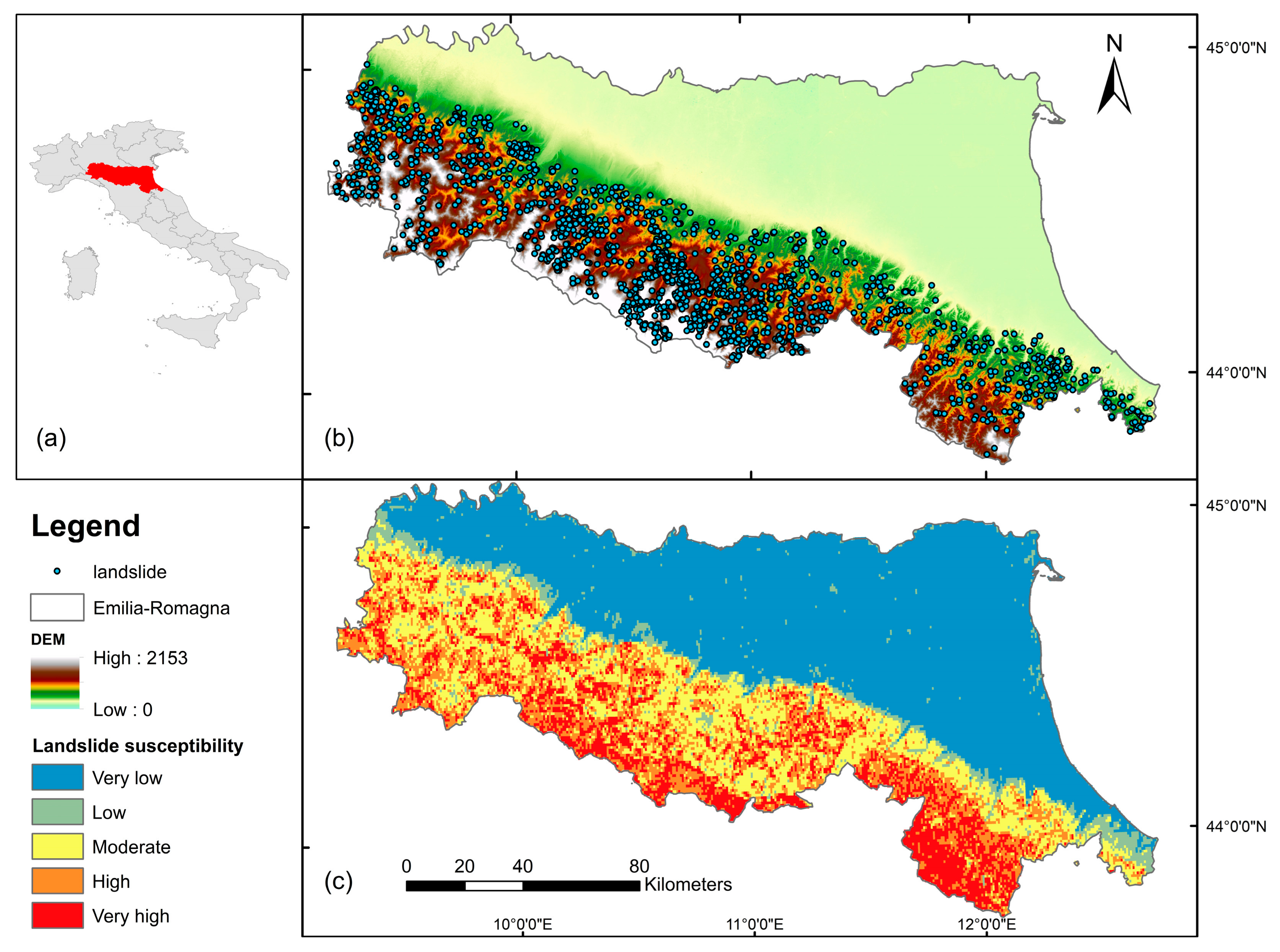

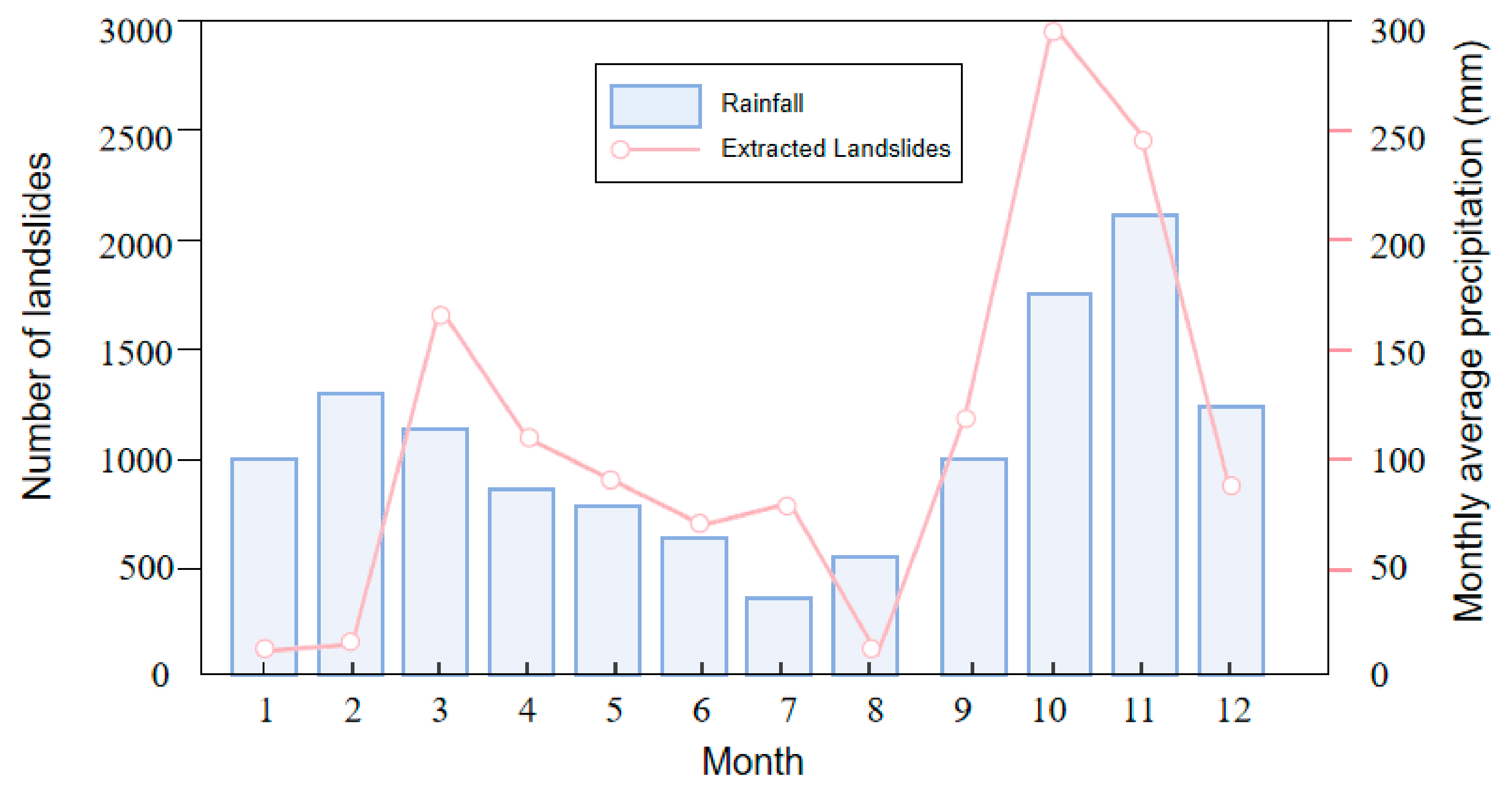
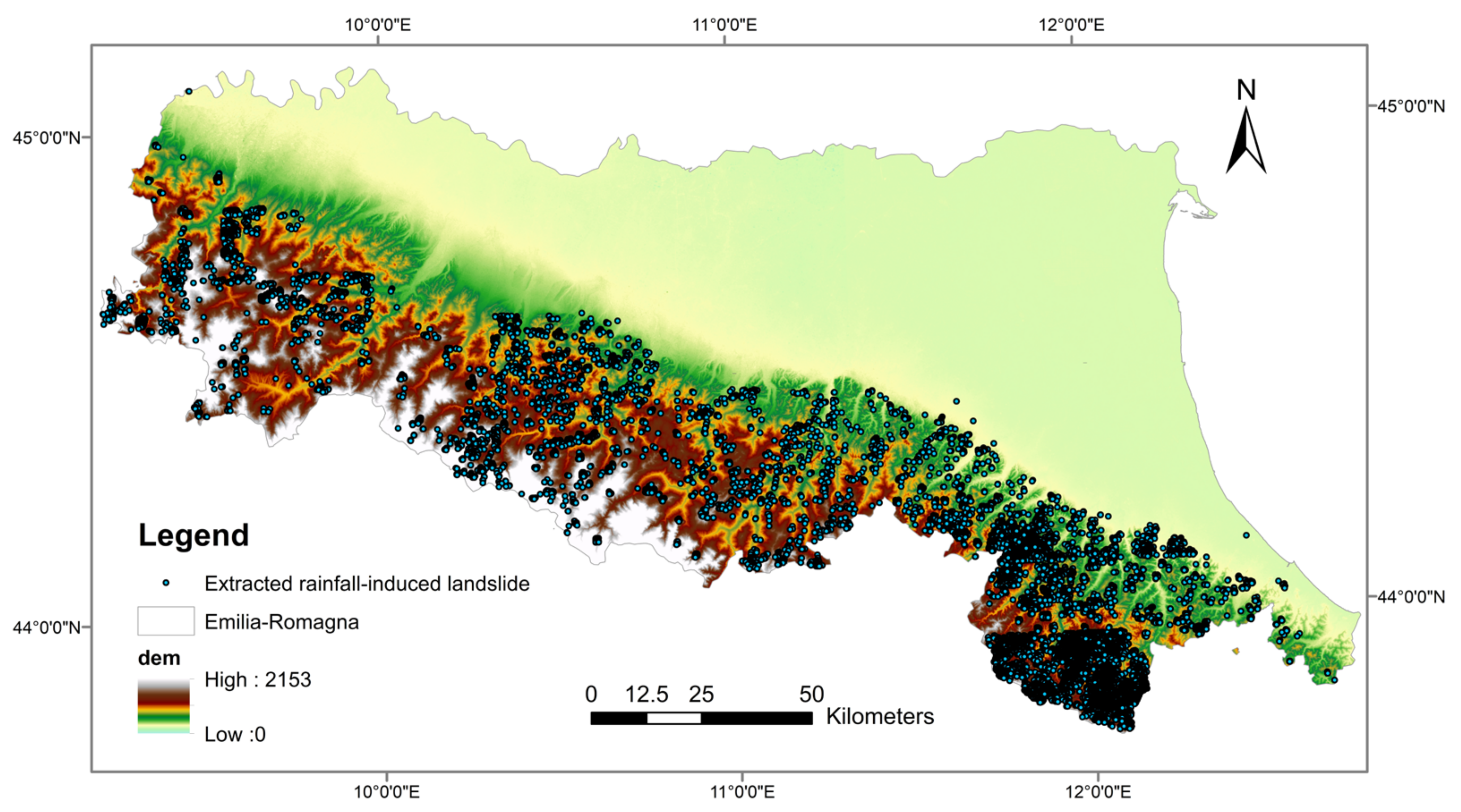

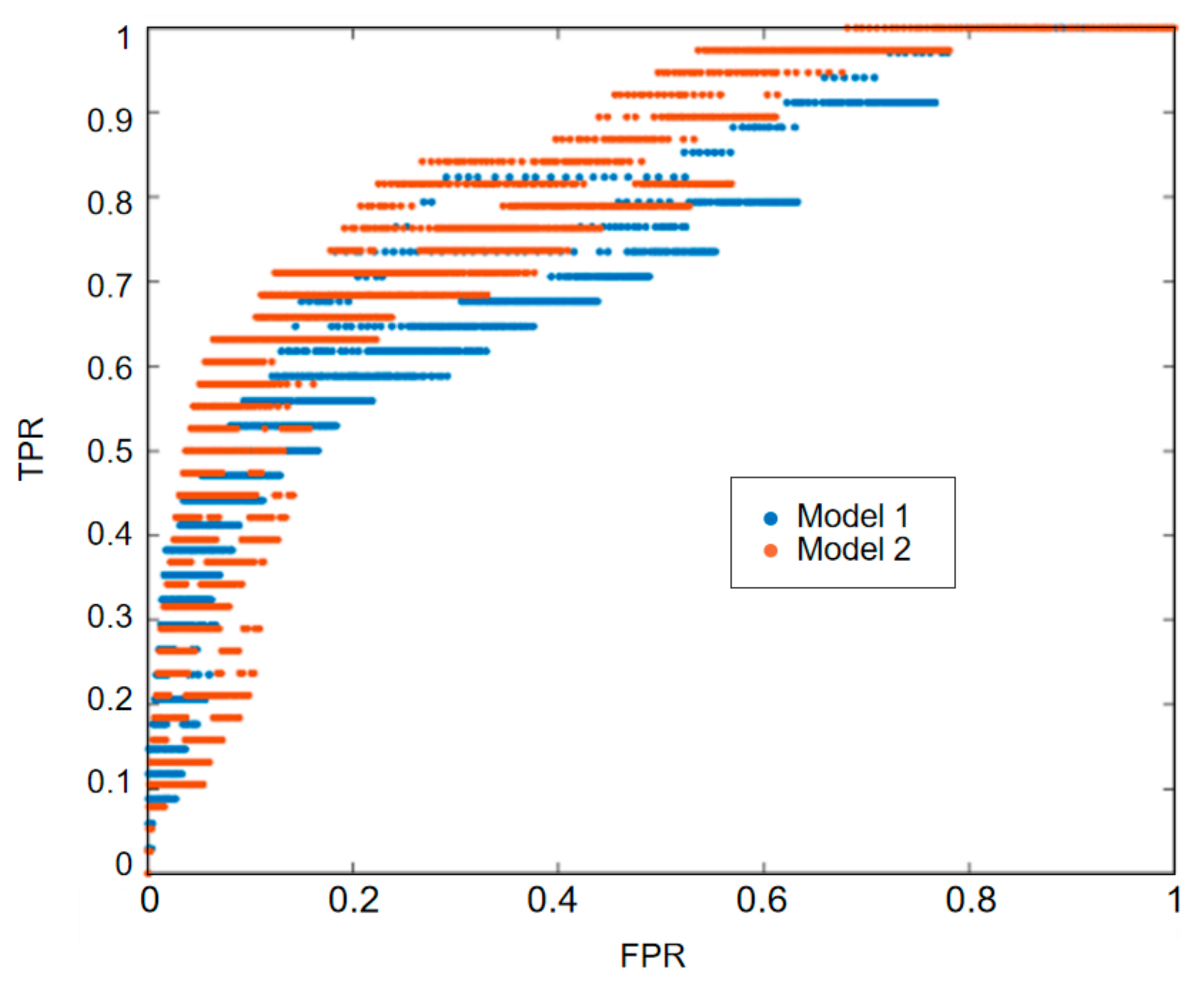
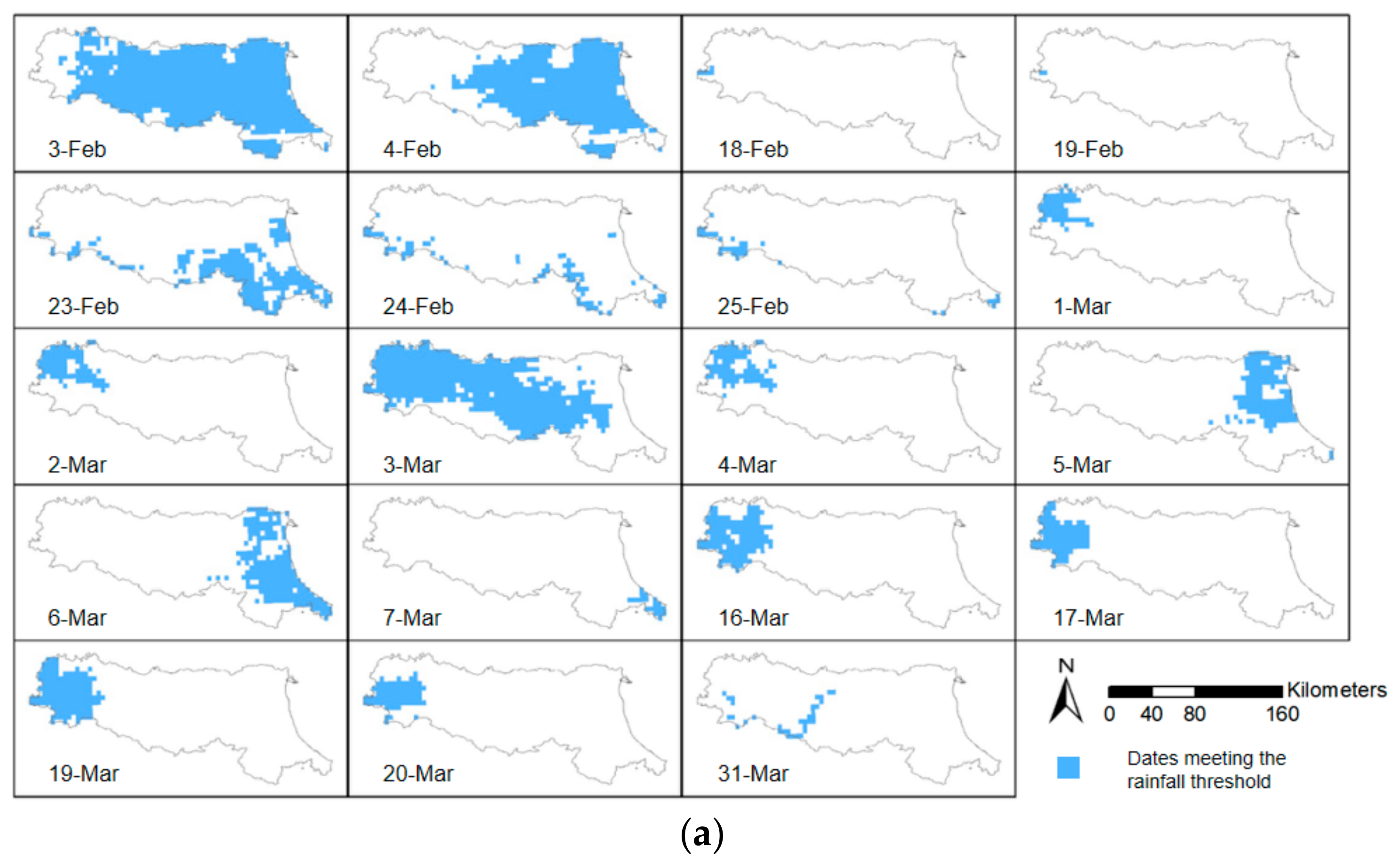

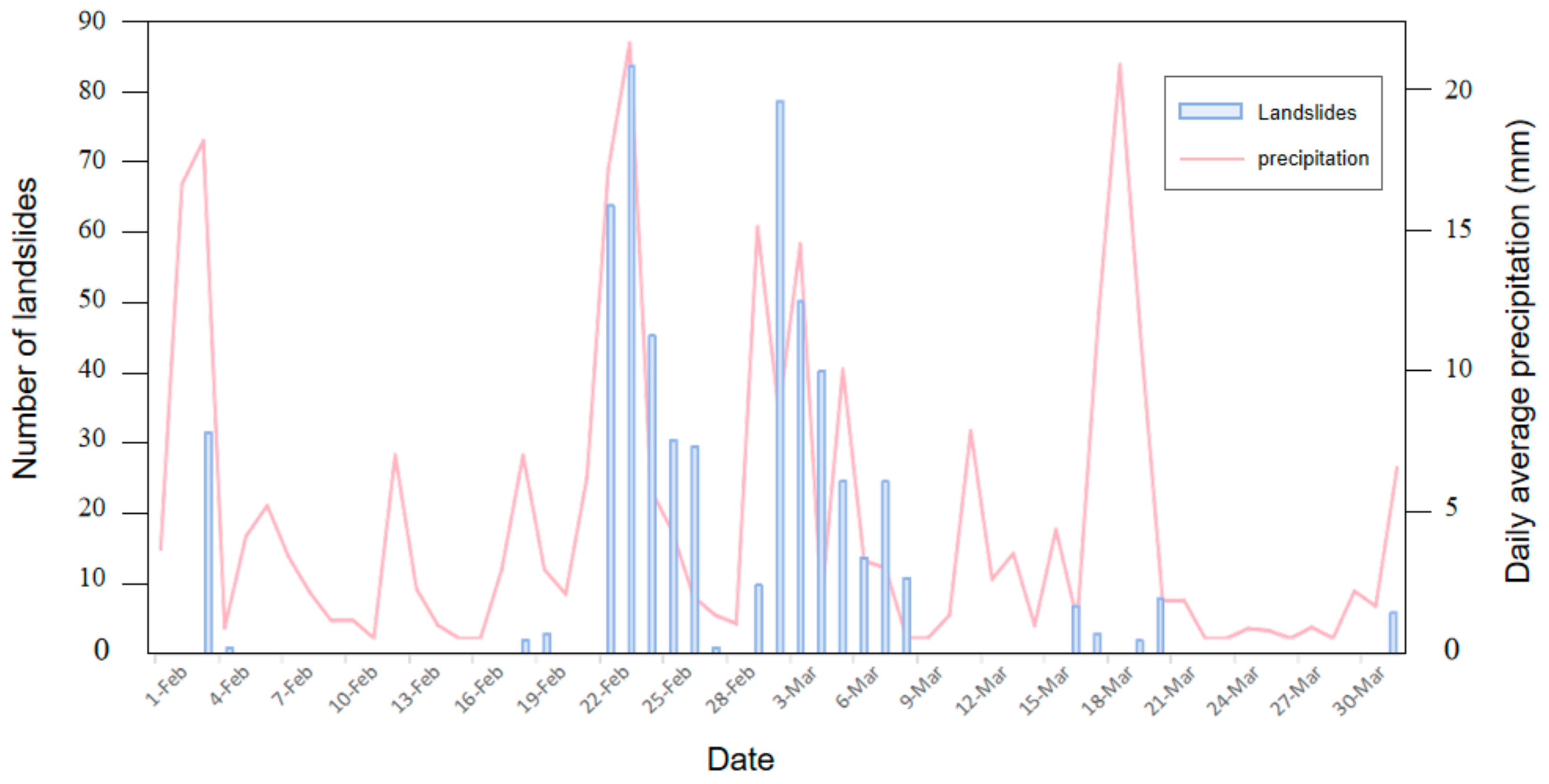
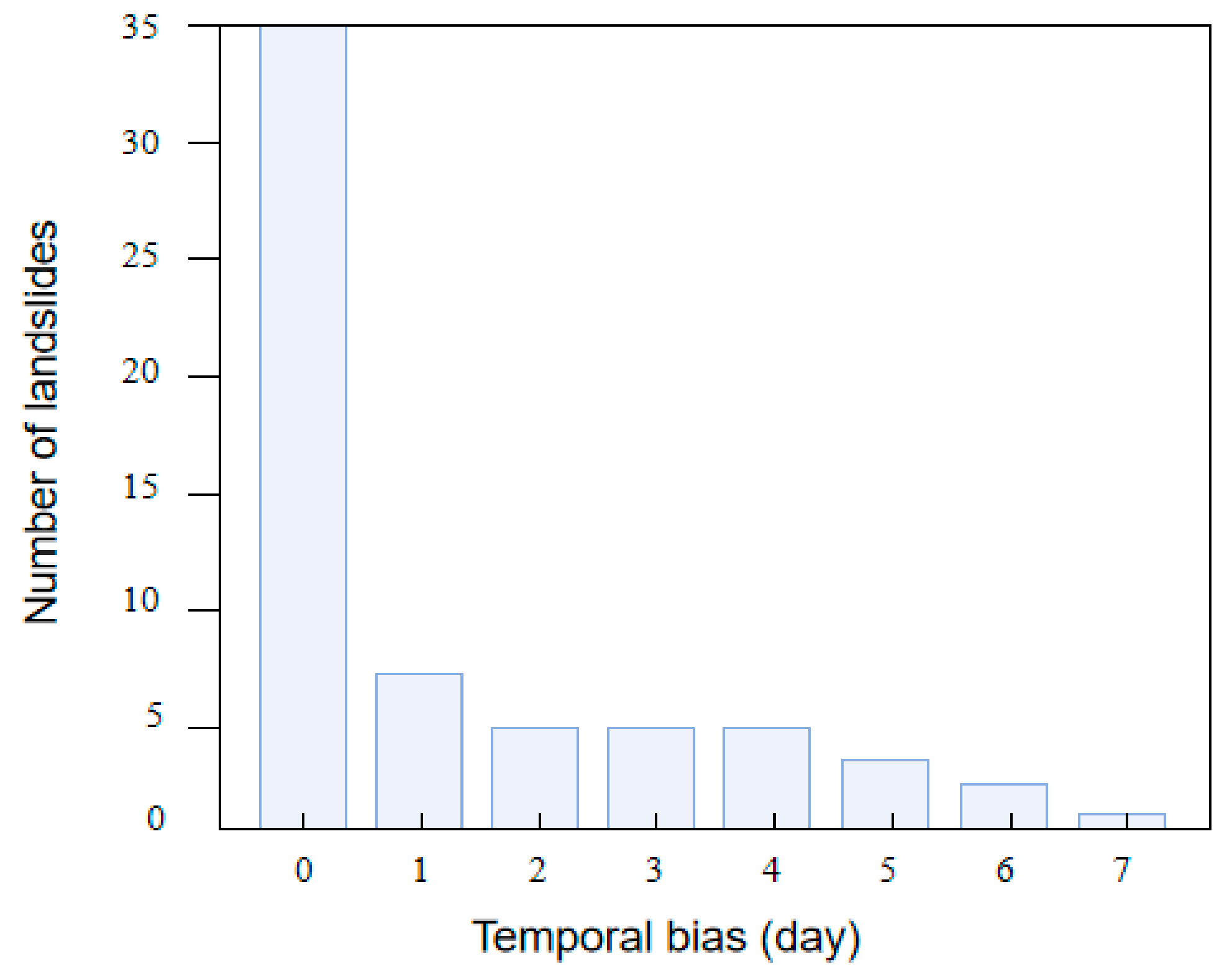

| Product | Temporal Coverage | Temporal Resolution | Spatial Resolution | Soil Depth |
|---|---|---|---|---|
| SMAP-PE | 2015 to present | Daily | 9 km × 9 km | 0–5 cm |
| SMAP-Sur | Every 3 h | 9 km × 9 km | 0–5 cm | |
| SMAP-RZ | 0–100 cm |
| 73.5%—20 mm | 75.5%—19 mm | 75.5%—20 mm | 78.5%—20 mm | |
|---|---|---|---|---|
| TPR | 0.82 | 0.70 | 0.83 | 0.83 |
| FPR | 0.39 | 0.21 | 0.32 | 0.22 |
| d | 0.43 | 0.37 | 0.36 | 0.28 |
| 73.5%—20 mm | 75.5%—19 mm | 75.5%—20 mm | 78.5%—20 mm | |
|---|---|---|---|---|
| TPR | 0.72 | 0.79 | 0.84 | 0.83 |
| FPR | 0.21 | 0.24 | 0.29 | 0.21 |
| d | 0.35 | 0.32 | 0.33 | 0.27 |
Disclaimer/Publisher’s Note: The statements, opinions and data contained in all publications are solely those of the individual author(s) and contributor(s) and not of MDPI and/or the editor(s). MDPI and/or the editor(s) disclaim responsibility for any injury to people or property resulting from any ideas, methods, instructions or products referred to in the content. |
© 2024 by the authors. Licensee MDPI, Basel, Switzerland. This article is an open access article distributed under the terms and conditions of the Creative Commons Attribution (CC BY) license (https://creativecommons.org/licenses/by/4.0/).
Share and Cite
Zeng, T.; Zhang, J.; Chen, Y.; Zhu, S. Extraction of Spatiotemporal Information of Rainfall-Induced Landslides from Remote Sensing. Remote Sens. 2024, 16, 3089. https://doi.org/10.3390/rs16163089
Zeng T, Zhang J, Chen Y, Zhu S. Extraction of Spatiotemporal Information of Rainfall-Induced Landslides from Remote Sensing. Remote Sensing. 2024; 16(16):3089. https://doi.org/10.3390/rs16163089
Chicago/Turabian StyleZeng, Tongxiao, Jun Zhang, Yulin Chen, and Shaonan Zhu. 2024. "Extraction of Spatiotemporal Information of Rainfall-Induced Landslides from Remote Sensing" Remote Sensing 16, no. 16: 3089. https://doi.org/10.3390/rs16163089
APA StyleZeng, T., Zhang, J., Chen, Y., & Zhu, S. (2024). Extraction of Spatiotemporal Information of Rainfall-Induced Landslides from Remote Sensing. Remote Sensing, 16(16), 3089. https://doi.org/10.3390/rs16163089







